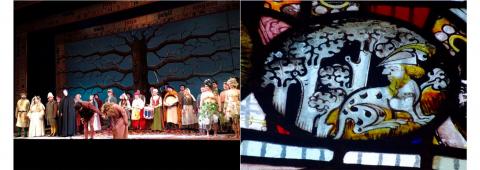Chaucer: Medieval Poetry and Modern Performance
This course covers the career-long development of Geoffrey Chaucer, greatest of English poets. Chaucer got to be great because he was free to write before English verse was dignified with the name of poetry. Before Chaucer poets writing in English, which was much less prestigious than Latin, French, or Italian, were known as makeres; watching Chaucer at work, contemporary poet Lavinia Greenlaw says, is like seeing English "before the paint has dried." We will begin by reading his great love poem of the Trojan war, Troilus & Criseyde, in modern English-- although reference will be made (materials provided by the instructor) to the Middle (medieval) English original. We then move on to The Canterbury Tales (CT) and switch to Middle English. CT is a framed collection of stories, juxtaposing knightly deeds of chivalry with low deeds of sexual opportunism; philosophical musing and tales of talking chickens; tales of liberty and tyranny; oriental exoticism and gritty, close-to-home realism; enlightened views of Islam and tales of wicked mothers-in-law; alchemy and magic; ecology and astronomy; saint's life and undergraduate escapade; freelance eroticism and married love. "Genre" never stabilizes in Chaucer: every new tale is a fresh adventure.
This is a poetry written to be read aloud, and to be performed. Each student will gradually come to read and perform Middle English fluently and well. And this will give you a good idea of where modern English comes from: Middle English is the floor upon which modern English walks; a frequent challenge is "etymologize that!" Our flower the daisy, for example, comes from the Old English dayes eye, "the eye of day"; the dandelion is from dent de lion ("the lion's tooth": such is the shape of its petals). Many modern poets find great inspiration in Chaucer-- especially women poets, including minority women poets: Sylvia Plath, Lavinia Greenlaw, Marilyn Nelson, Caroline Bergvall, Patience Agbabi, Jean Binta Breeze, Pattie McCarthy. You might be similarly inspired into creative response. Chaucer is especially famous for his great female characters (such as his Wife of Bath). In this, and in much else, he resembles the poet from whom he took most, the Italian Giovanni Boccaccio; we will spend some time comparing their works, especially their great framed collections, the Decameron and The Canterbury Tales.
Form of Assessment: Assignment 1, in-class language test (10% of grade); assignment 2, translation and commentary, 20%; assignment 3, short essay, 20%; assignment 4, longer essay with research component, or creative project with production notes, 40% of grade; preparation and participation, 10%. There will be no midterm or final, and all assignments except the first will be submitted as .doc by e-mail, and will be graded via Track Changes. This will allow folks who need to travel for religious holidays to submit early, if necessary.
Texts required:
Chaucer, The Canterbury Tales, ed. Jill Mann (Penguin).
Boccaccio, Decameron, tr. G.H. McWilliam (Penguin).
Chaucer, Troilus & Criseyde, tr. B.A. Windeatt (Oxford World Classics).
Text not required:
David Wallace, Chaucer: A New Introduction (Oxford UP, 2017)
Teaching Assistant & Grader: Aylin Malcolm, PhD Student, Department of English

 Department of English
Department of English
